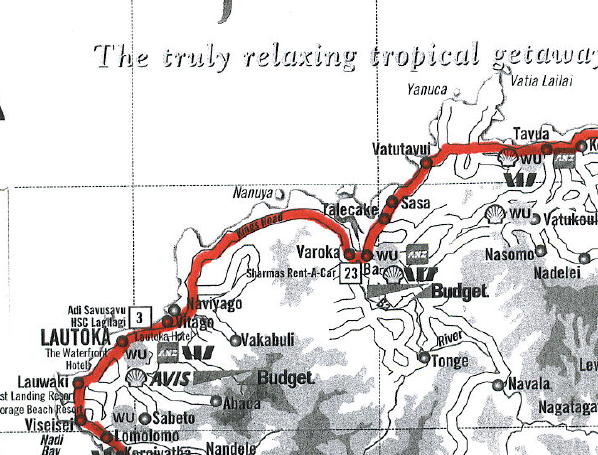Overview
This is a friendly and welcoming place. There’s a genuine feeling of fun. The place is also beautiful but from a road bikers point of view its very limited by the road quality. The best time for bike touring would be in the dry season when it’s a little cooler and less humid otherwise it is hot, humid and sweaty. You sweat and drink all day. Also, its mostly a water sports destination. What a place to sail, dive or sunbath. We stopped here for two weeks on our way home from New Zealand. We wanted tropical weather and relaxation. We got it but I would never come here as a destination to bike. Its too limited and probably too hot, but we liked it for two easy riding weeks.
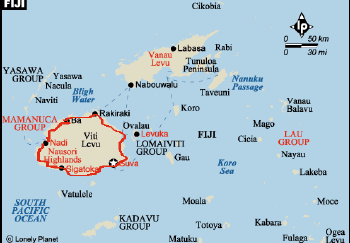
How We Rate This Trip
Roads: 2
Or should I call it “road” since there’s only one paved road. This road circles Viti Levu. Its all paved except for about 35Ks in the eastern part of the island. This road will be completed soon and the circle trip will be a good one. The newer parts are better and wider. All other roads are gravel and rough for those who like the going rough.
Traffic: 4
The best, quietest road is from Ba and east on the north coast. This section is biker heaven (especially down wind). Around Nadi and Suva the traffic can be intense. There are times of the day when its busier around the cities. Traffic into towns is busy in the AM and the traffic out is busy in the PM. Sundays and Holidays are less busy except at the end of an extended weekend like Easter when all the locals are returning home.
Weather: 6
During the rainy (and hotter) season, it is very warm and humid. I’ll tell you hot: climbing with a tailwind in the middle of the day in the rainy season. Water intake becomes critical. The heat reduced the distances we covered each day. The best time to come is in the dry season when it’s a few degrees cooler and a bit less humid. This occurs during the April to September period.
Winds: 7
It’s the predictable trade winds almost always from the East South East. Its calmer some days but the winds generally get stronger through the day. So its better to beat the stronger winds by going east early in the day and west later in the day when you will get more of a push. Because the only sealed road goes around the large island, Viti Levu, this is where we biked so either on the north coast or the south coral coast going west is easiest.
Scenery: 6
The road goes right beside the coral coast for 50Ks. Just beautiful coastal scenery. But then the ring road heads inland and at times the scenery is somewhat dull. Then the road goes near the coast again west of Raki Raki. So it’s a mixed bag on this one sealed road. I wish there were roads inland. I think it would be brilliant. It’s a beautiful country but I mark it down from the road cyclist’s point of view. Probably, from the sailor’s perspective it could be a 10.
Information: 2
There are basically no tourist offices; only travel agents who represent certain hotels and tour operators. We arrived without the Lonely Planet guidebook and we were at a loss. Eventually, we got one and it helped immensely. Suffice it to say that biking is not a big pursuit here. We never really completely understood how much of the circle route was completed or when it would be completed.
Road Safety: 7
You hear of the wild Fijian drivers but our experience (2 weeks) was that they all showed respect for us as cyclists. The roads are often narrow and there are usually no shoulders but if there was no approaching traffic, all cars, busses and trucks gave us plenty of room when they passed. When the traffic was heavy we rode defensively including waiting for lines of traffic.
General Safety: 7
OK, a kid tried to pick pocket me in Suva but really this is a very safe place. We walked around at night in all the cities and we were not concerned. Its reported that crime is on the rise but we felt very secure. The racial tension between the Indo Fijians and the Fijians is always a concern but both sides have no quarrel with the tourists.
Value: 4
You end up at Resorts and they tend to be pricy for both rooms and food. The best deals we got were in the towns that still have old colonial hotels where both the rooms and the food were better deals. A good deal is the “Happy Hour” for drinks and snacks offered by almost all places.
Fluids: 5
We drank the tap water from time to time with no negative effects but mostly we drank the 1.5 liter Fiji Water in plastic bottles. Usually we got it at least cool. You drink lots of water to replace sweated out body fluid. Coffee is available but seldom very good. All sorts of Soda Pop is available but gets tiring. We liked the coconuts and watermelons from the roadside vendors. Fiji beer is very good. Wine is available at restaurants. A good place for cold beer is in the private clubs, which usually are happy to serve tourists.
Food: 4
We are partial to curry but often the curries of Fiji have been Fijiafied to the point where you can’t really call them Indian food. Some of the restaurants at the resorts and at the colonial hotels were better and even offered passable curry, fish, pizza and even steaks.Often, the independent restaurants in the towns offered poorer quality. Breakfast was often a rip-off.
Accommodations: 4
We mostly liked the older colonial hotels like Rakiraki, Tavua and Nadi. Next choice were the places at Sunset beach near Sigatoka and the new town (beach) of Nadi. Generally, they were nice places at reasonable prices. Camping, I think, would be tough with the heat and the rain.
People: 8
All Fijians, both native and Indian, were friendly, helpful, genuine and full of happy life. Everyone greets you. You are greeted with a heart felt “Bula” (Hello, Welcome) hundreds of times a day. Everyone smiles. Its like this, one night I spent too much money on dinner. We were walking home with little ready cash. A taxi stopped, unhailed and I said to him, “I have no money.” He said, “Jump in. I’m going that way anyhow.” We just loved these people.
Culture: 3
Its an interesting mix of left over colonial, native Fijian and Indo Fijian. There is nice pop music and there is the sports culture. It’s the land of Vijay Singh and the World Champs of Rugby 7’s in 2005. We were here when the 7’s won and the country went nuts. It was great! The Fijians are great world-class athletes.
History: 2
It’s a relatively short but dynamic history with the colonial period, the arrival of many Indian peoples and then the subsequent strife with independence and divide between the Indo Fijians and the native Fijians. This part of history is still unfolding. The physical evidence of olden times is minimal.
TOTAL SCORE 71
Route Descriptions and Maps
Nadi to Sigatoka on Queens Highway 63Ks
2-lane, no shoulder, polite traffic, less and less traffic as you go. Some trucks. Very gradual rolling hills then at 17Ks a gradual to moderate 3K climb. Uninteresting rural scenery. Variable winds, plenty of sweat, occasional rain. Sometimes it rains for hours. Gradual 1-2K climbs and descents. Occassional stores. At 42Ks, a steeper 1K. OK scenery. Light traffic. At 46Ks, steep 1K descent to coast. Near Cuvu at 47Ks there is a side road to the right, partly sealed and partly gravel for 5Ks along the sea. Back to Hwy at 54Ks. Again rolling and gradual to Sigatoka.
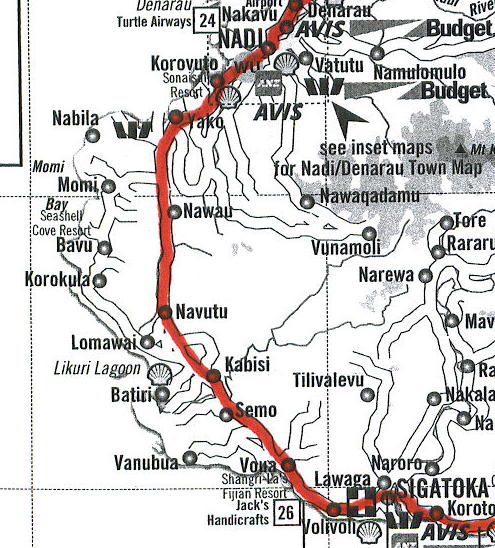
Sigatoka to Pacific Harbour 79Ks
Over Melrose bridge then, at 8Ks, right toward resorts along coast, Sunset Beach. Then cut up thru Outrigger Resort to Hwy at 9 Ks then right along the ocean. Beautiful. Light to moderate traffic, 2-lanes, no shoulder, mostly flat, a few small hills. At 40Ks, the Beachhouse. 1K up to 42Ks then down 1K. Tropical coastal beauty. Now inland at 44Ks. Lots of hills, steeper and more frequent to 68Ks. Many tough climbs. Then finally back to the coast for a beautiful, last, flat 10Ks to Pacific Habour. Headwinds into the East South East trade winds.
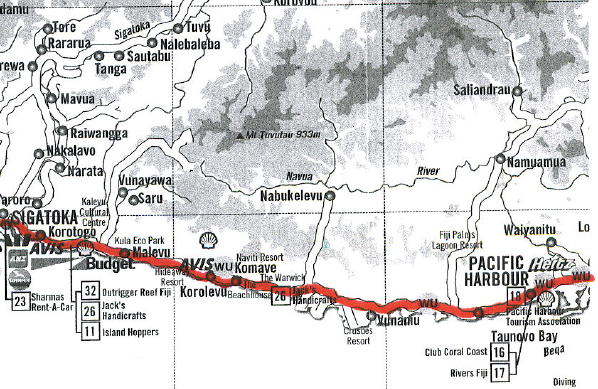
Pacific Harbour to Suva 48Ks
2-lanes, no shoulder, more traffic and fast moving here. Flat for 19Ks. No sea views, so so scenery, then gradual hills. Parts of this road are in disrepair. Bumps. At 26Ks, a 1K moderate climb. Then more gradual hills. Two things that help with the fast traffic:1) Speed humps (bumps) in the villages and 2) Passing lanes going up hill. The road remains narrow but much busier into town at 48Ks.
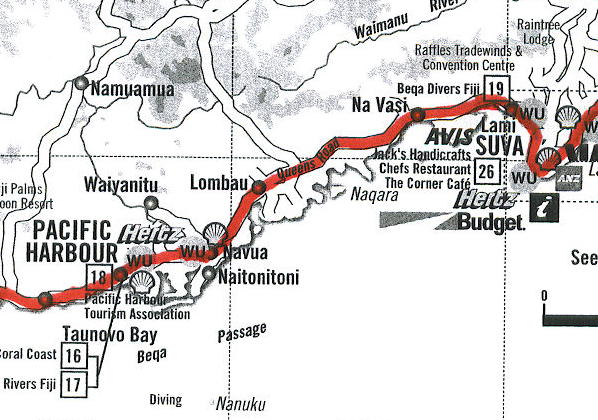
Suva to Nausori 20Ks (Not Riden)
On the Kings Hwy. It’s the busiest and most conjested stretch of highway in Fiji. Best out on Queen Elizabeth Rd to Kings Rd. The airport is 3Ks southeast of Nausori. The roads are sealed.
Nausori to Korovou 31Ks (Not Riden)
This part of the Kings highway is tar sealed. That’s all I know.
Korovou to Ndama 56Ks (Not Riden)
This is the last section of the road around the island to be improved. Its hilly and its rainy here so road improvements are slow. Its still undergoing road works in 4/05. Maybe finished next year? Part is now sealed. Reportedly its sealed to Nanggai from the north.
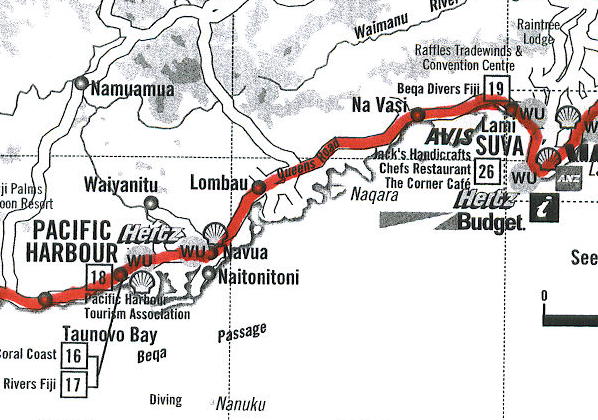
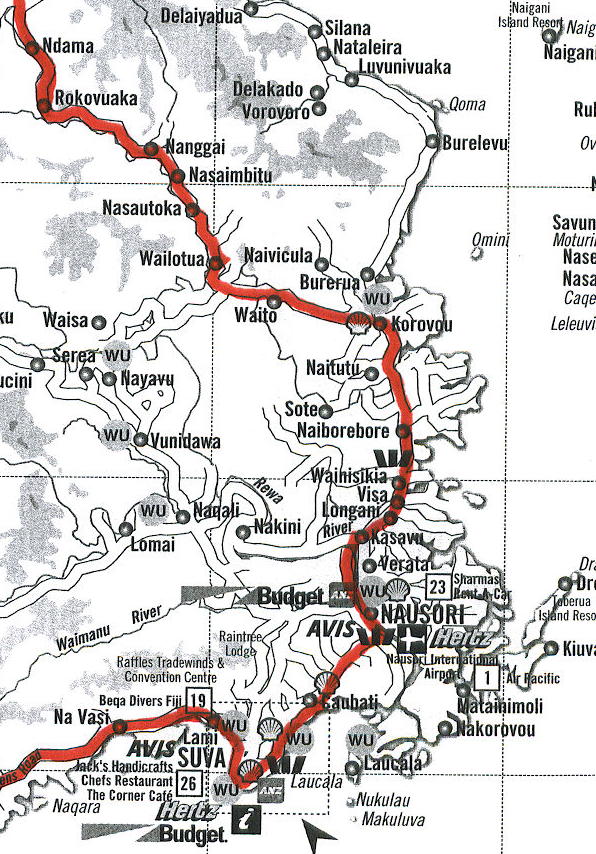
Ndama to Matawailevu 12Ks (Not Riden)
This is a tar sealed road and it looked as if it was mostly level and reported to be so. The road traverses a plateau. The towns are poor and water is not always available at the stores (warm soda pop is available).. Very quiet road in good repair. So so scenery.
Matawailevu to Rakiraki junction 39Ks
Matawailevu is on a plateau and the road is tar sealed. The sealed road is reported to start in Nanggai in 4/05. Its reported to be mostly flat till the gravel section which is reported to be hilly. Cross winds. Very quiet road, 2-lanes. At 3Ks, down and rolling to Barotu at 6Ks. Then one more hill before the bay at 8Ks. 3 hills along the bay. Good store at 19Ks. Now turn west. Strong Tailwinds. Gradually rolling along coast. Beautiful, quiet, bicycle heaven. At 29Ks, junction for Ellington Wharf then one moderate hill. Rakiraki Hotel at 37Ks then Rakiraki junction at 39Ks.
Vaileka (the main town of Rakiraki) to Ellington Wharf 14Ks
(This is to help guide you through the spread out Rakiraki area)
2Ks over a steep short hill to Kings Rd. At Rakiraki Junction, right on quiet 2-lane road. At 4Ks, Rakiraki Hotel then one moderate hill to junction for Wharf at 12Ks then left on sealed road to dock at 14Ks. Strong east winds.
Rakiraki Junction to Tavua 41Ks
Kings road west, 2-lanes, light traffic, some spots of disrepair. Good scenery, Some hills, some sea views. As you get closer to Tavua, its flatter. Along the sea but through mangroves so there are no real sea views. This is the driest part of Fiji. (It rained.) Tailwinds.
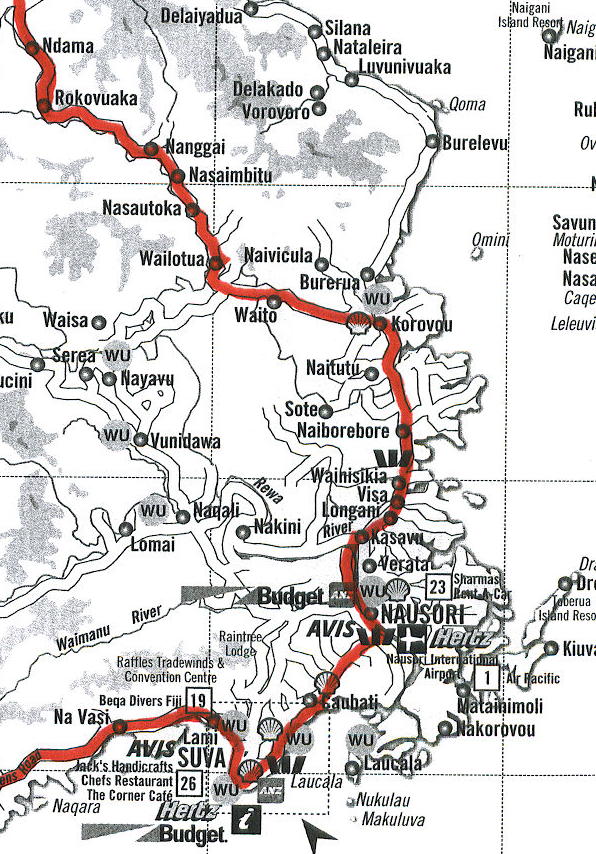
Tavua to Ba 26Ks
Wide, 2-lanes, mostly flat. A few gradual ups and downs, tailwinds, increasing traffic but still light. Sugar cane fields, a few views of the sea. OK scenery, a few shops. 25Ks then off Hwy to town.
Ba to Lautoka 37Ks
1K out to Kings Hwy, left. Busy in and around Ba. More hills. Strong tailwind, good scenery and sea views. Container trucks come in bunches. Otherwise moderate traffic. Road is mostly improved and wider 2-lanes but sometimes its older and narrower. At 22Ks, climb, some steep for 1.5Ks. You see Lautoka from the top. 1.5Ks down then flat. The road is narrow, rough and busy into Lautoka 37Ks.
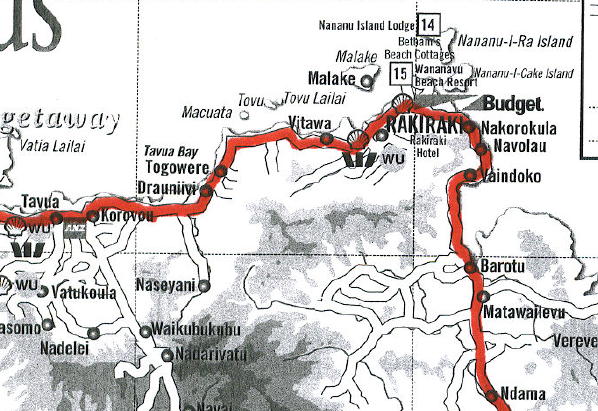
Lautoka to Nadi (New Town, Beach) 31Ks
Take the city streets past Fisherman’s wharf to circle with Queens Rd., 4Ks. 2-lanes, busy, no shoulder, ride defensively, through population. A couple easy hills. At 10Ks, the road is wider, sometimes 4-lanes, sometimes a shoulder. At 12Ks, from a hill you can see the airport and Nadi. At 14Ks, across a narrow bridge and the road is narrow again. At 17Ks, 4-lanes. At 18Ks, 2-lanes again. At 19Ks, a narrow 150 meter bridge. Narrow road to airport at 23Ks. At the circle, at 25Ks, toward Nadi Town Center on a very busy road usually 3-lanes. At 29Ks, right to Nadi Beach (New Town). 1K in then right to New Town 31Ks.
Nadi (New Town, Beach) to Nadi Town 8Ks
1K then left 1K to main road. 2Ks then right 4Ks to Nadi town. All flat.
Road Stories
E-mails from Fiji in March 2005
The thin Fiji guide book at the New Zealand Airport was $40. We read it in the Airport book shop and gleaned that there is an excellent tourist information at the Fiji airport. Wrong. So we ran the gauntlet of “Come to my hotel,” “Let me help you, Sir,” “Best price,” as we discovered there was no tourist information at the airport and if there was it would be closed on Sunday. The next day we left Nadi late due to information gathering. On our way we had to stop and wait out a down pour in the afternoon. You know the 30 minute tropical rain that is touted in the tourist brochures but this rain lasted hours. It was getting late and our only option was to return to Nadi. I found a nice pick-up truck with a covered back for $20. Peter said “That’s too much.” I said, “We went to the beach for $7 last night, this is 100 times further, it’s a deal.” He said, “NO, I will find a better deal.” We set off on our bikes in a light rain. Then it began to pour again and became hard to see. In this kind of rain bicycle breaks become useless. Not far from Nadi, on a downhill Peter hit a submerged pot-hole. He barely kept his balance avoiding what could have been his biggest crash ever but blew both front and rear tires. A pick-up stopped as he was removing his front tire. The driver said, “$20”. Peter said, “Good Deal.”
The Fiji 7’s Rugby Team won the MELROSE CUP in Hong Kong on Sunday night. You probably never heard of this but it is the equivalent of the World Cup in Soccer only Rugby. Ironically, for us, Fiji beat New Zealand who prizes themselves as the World’s best in Rugby. Fiji declared Thursday a National Holiday. On Wednesday the team, named the “Kings” flew into Nadi and were bussed 200Ks to their home in Suva. The entire 800,000 population is celebrating. The Fiji Flag is the Team Flag. Sky blue flags, some small, some full size fly from every car and bus. On Wednesday, we were at the MELROSE bridge in the middle of the route to Suva. “The team and “Captain” (the most famous player) will be here at 9AM – they will walk across the bridge named when the team last won in 1989.” We decided not to wait. Along the road, everyone was jazzed with anticipation. They had banners, flowers and gifts. The usual friendly greeting of “Bula, Bula” was paired with
chants of “FIJI, FIJI.” All day we got reports, “The Team is still in Nadi,” “They stopped for lunch,” “They are having dinner now.” The 4 hour bus trip took the Team 18 hours with villagers road-blocking the procession for a better glimpse of ther heroes. And heroes they are. In Pacific Harbor, we met a young man from Suva. He told us this story. He and some friends were walking home from school a few years ago. They saw the “Captain” driving past and waved to him. He stopped and said “Do you need a ride?” They said “No, we want your autograph.” He gave them all photos with personal messages for them and their families. (Imagine any of our sports stars doing this) We arrived in Suva to a sea of white “FIJI WORLD CHAMPIONS 2005,” t-shirts. The biggest t-shirt sale per capita in history. We will stay a couple days in this excitement and hope to see the “Captain” and wave him down. We think he will stop.

